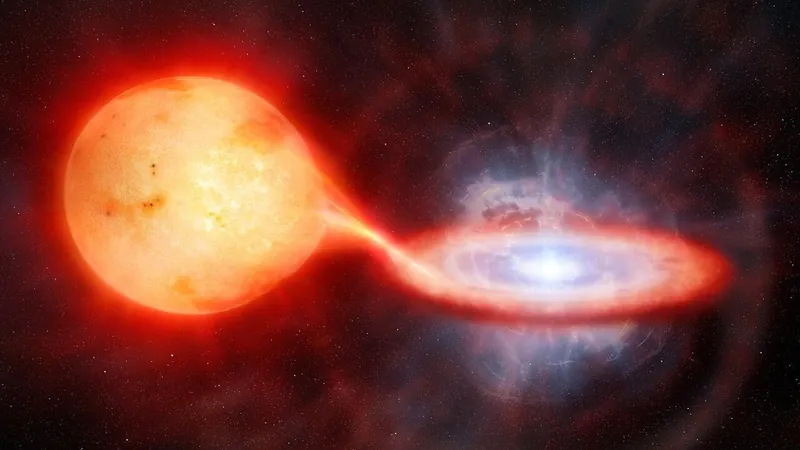
Unveiling the Universe: The Most Intense Recurrent Nova Discovered Beyond the Milky Way!
2025-03-23
Author: Siti
In an astonishing breakthrough, astronomers have identified a repeating explosion in the cosmos—now recognized as the hottest burst of its kind ever recorded. This remarkable event, named LMCN 1968-12a, is located in the Large Magellanic Cloud, a neighboring dwarf galaxy to our Milky Way, making it the first recurrent nova outside our galaxy to be studied in near-infrared light.
LMCN 1968-12a stands out not only for its extreme temperatures but also for its violent eruptions and unique chemical signatures that starkly contrast those typically observed within our galaxy. The findings were revealed in a paper published in the esteemed journal Monthly Notices of the Royal Astronomical Society.
What Is a Nova?
A nova occurs when a white dwarf—an remnants of a star—pulls material from its companion star in a binary system. The process leads to a bright, explosive display in the night sky—a phenomenon that can last for weeks or months, only to fade away, unlike a supernova, which results in the complete destruction of a star.
As the white dwarf siphons gas from its partner, the accumulating material forms an accretion disk. This magnetic swirl heats up due to intense pressure, igniting a runaway thermonuclear reaction where hydrogen burns into heavier elements. The resultant explosion ejects a substantial amount of material and energy, creating a spectacular nova display.
Named "recurrent" because these explosions happen at regular intervals—ranging from months to years—LMCN 1968-12a has been consistently erupting every four years since its discovery in 1968.
A Closer Look Through High-Tech Telescopes
More than just a pretty spectacle, these events expose the dynamism of binary star systems under varying conditions. The latest eruption of LMCN 1968-12a occurred in August 2024, prompting follow-up observations through the Magellan Baade and Gemini South telescopes in Chile, which captured the intriguing near-infrared light emitted nine and 22 days post-eruption, respectively.
The data revealed an extraordinary brightness in ionized silicon—95 times brighter than sunlight over all wavelengths—with a surprising absence of other expected elements like sulfur, phosphorus, calcium, and aluminum. Such anomalies sparked excitement among researchers, leading to new hypotheses regarding the eruption's temperature and intensity. The expelled gas likely reached a staggering temperature of 5.4 million degrees Fahrenheit (3 million degrees Celsius), suggesting a direct link between the explosive characteristics and the surrounding environment.
The Influence of Metallicity
One hypothesis explains that the large Large Magellanic Cloud has a lower metallicity compared to the Milky Way, which results in fewer heavy elements. In turn, this lack of heavy elements allows for more material to accumulate on the white dwarf's surface prior to ignition, leading to even more explosive outbursts.
Previous predictions posited that low-metallicity environments would facilitate intense nova events, and this discovery supports that theory. Not only has LMCN 1968-12a opened new avenues for research, but it also highlights the crucial role that different chemical environments play in cosmic phenomena.
What’s Next for Astronomical Research?
As scientists prepare to utilize larger telescopes to investigate novas across various galaxies, this unprecedented discovery of LMCN 1968-12a is poised to deepen our understanding of stellar dynamics and the intricate processes that govern explosive cosmic events. Could these revelations rewrite the cosmic rulebook on stellar explosions? Only time will tell, but one thing is certain: the universe still has many secrets waiting to be unveiled!



 Brasil (PT)
Brasil (PT)
 Canada (EN)
Canada (EN)
 Chile (ES)
Chile (ES)
 Česko (CS)
Česko (CS)
 대한민국 (KO)
대한민국 (KO)
 España (ES)
España (ES)
 France (FR)
France (FR)
 Hong Kong (EN)
Hong Kong (EN)
 Italia (IT)
Italia (IT)
 日本 (JA)
日本 (JA)
 Magyarország (HU)
Magyarország (HU)
 Norge (NO)
Norge (NO)
 Polska (PL)
Polska (PL)
 Schweiz (DE)
Schweiz (DE)
 Singapore (EN)
Singapore (EN)
 Sverige (SV)
Sverige (SV)
 Suomi (FI)
Suomi (FI)
 Türkiye (TR)
Türkiye (TR)
 الإمارات العربية المتحدة (AR)
الإمارات العربية المتحدة (AR)